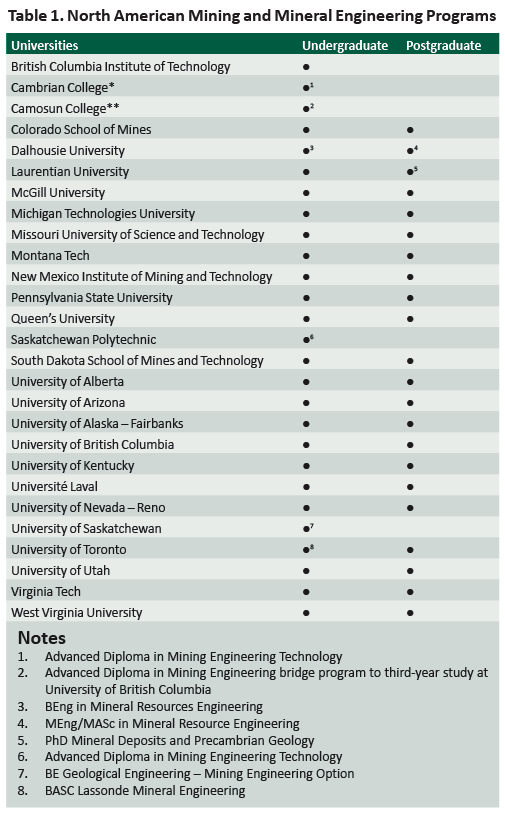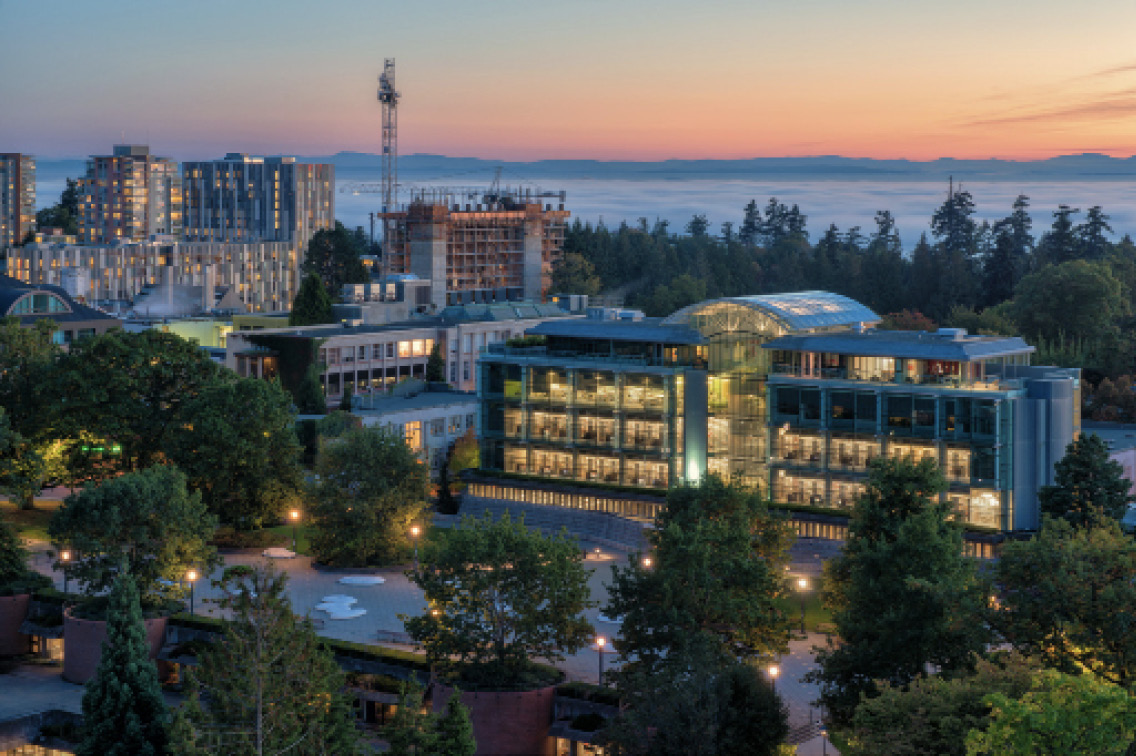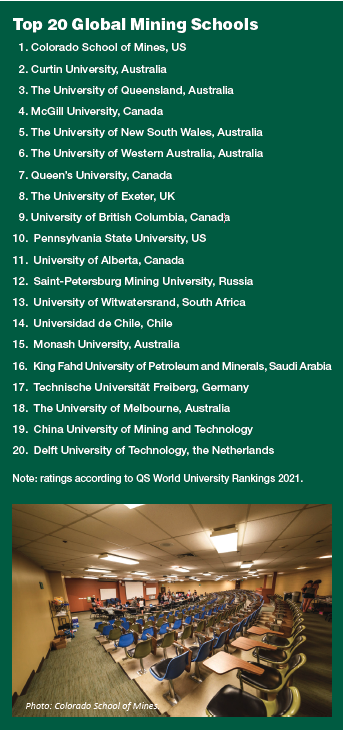Mining Schools Play A Vital Role In Equipping The Industry With The Next Generation Of Talent. Here’s Our Overview Of North American Institutions – And How They Compare To Their International Counterparts.
By Jonathan Rowland

As is often pointed out, one of the challenges facing the mining industry is a lack of skilled workers. Yet, according to the Society for Mining, Metallurgy and Exploration (SME), there has been a steady decline in the number of mining and mineral engineering programs in U.S. colleges and universities from a high of 25 in 1982 to just 14 in 2014.1
That number appears to have remained stable over the intervening year: in our research, we found 14 institutions offering mining engineering or equivalent degree courses in the U.S. (Table 1). In Canada, the number was 13, although fewer offered postgraduate study or research options.
Top-Ranked Mining Schools
According to the QS World University Rankings 2021, North America is home to five of the top 10 mining schools.2 Colorado School of Mines tops the global list and is joined by Pennsylvania State University as the U.S. representatives, while McGill University (4), Queen’s University (7) and University of British Columbia (8) are the three Canadian institutions that make the cut.
Elsewhere, the Advanced Mine Energy Systems research group focuses on the application of microwave-assisted fragmentation in the excavation and comminution of hard rocks ores, while the Laboratory for Accelerated Discovery in Research Engineering aims to assist the mining industry in incorporating digital technologies into their operations to create a more resilient and sustainable sector.
Colorado School of Mines
Located in Golden, Colo., adjacent to the Colorado Mineral Belt, the Colorado Schools of Mines has headed the QS World University Rankings since 2016. Its high-profile faculty is led by Prof. M. Stephen Enders and Prof. Jürgen Brune, supported by an additional 10 staff members. The school’s Mining Engineering Department also operates the Edgar Experimental Mine, an underground laboratory where students can gain hands-on experience in underground mine surveying, geological mapping, rock fragmentation and blasting practice, mine ventilation, rock mechanics instrumentation and mine safety.
In addition to its degree programs, the department offers the Energy, Mining and Construction Industry Safety Program, a mine rescue training facility for use by the mining industry. Courses are conducted at the Edgar mine or on location at mine sites anywhere in the U.S. and can be tailored to meet the specific needs or conditions of virtually any mining environment.
McGill University
Montreal-based McGill University is Canada’s oldest mining school, having celebrated its 150th anniversary in 2021. The mining engineering program is housed within the Faculty of Engineering and includes a number of specialist laboratories, including the Mine Design and Numerical Modelling Laboratory, the COSMO (Stochastic Mining Planning) Laboratory, the Mineral Economics, Mine Reliability and Asset Management Laboratory, the Geomechanics Laboratory.
Research groups include the Earth/Mine Energy Resource Group (EMERG), which investigates the development of sustainable energy from both active and abandoned mines, and the Mine Multiphysics Research Group, which focuses on modelling studies of multiscale and multiphysical problems in mining, minerals and energy extraction.
Queen’s University
Ontario’s Queen’s University has been a center for mining education for 125 years. Today, the Robert M. Bucan Department of Mining is the largest mining department in Canada – and one of the largest in the world – accounting for about 33% of all Canadian mining and mineral processing engineering graduates. Prof. Julian Ortiz heads a faculty of 11 academics, supported by a large adjunct facility and technical and support staff.
The university is also the only university in Canada with its own Explosives Test Facility, which is located about 50 km north of the city of Kingston. The facility comprises two blasting chambers and bunker, equipped with an ultra-high-speed streak and framing camera, digital oscilloscopes, a portable data acquisition system, VOD monitors, a Hycam high speed camera and two Locam relatively high-speed cameras. On-campus equipment includes a gas chromatograph, digital image analysis systems for fragmentation analysis and numerical modelling tools for the analysis of explosives performance and sensitivity as well as the calculation of damage, fragmentation and throw in commercial blasting applications.
Other laboratories include the Kostuik Mine-Mechanical and Offroad Robotics Laboratory, as well as facilities specializing in geotechnical instrumentation, microwave extraction, mineral processing, rock mechanics, surface and underground mine design and ventilation.

University of British Columbia
The Norman B. Keevil Institute of Mining Engineering at the University of British Columbia’s Vancouver campus is headed by Prof. Scott Dunbar, who leads a faculty of 10 academics, supported by a wider adjunct faculty, sessional lecturers and staff. Instructional facilities are based in the Frank Forward building with additional teaching and research facilities in the Coal & Mineral Processing Laboratory.
Research centers at the Norman B. Keevil Institute of Mining Engineering research some of the most cutting-edge areas of mining engineering. The Urban Mining Innovation Center, for example, investigates scientific, business and social approaches to the recovery of valuable resources from urban waste streams. These waste streams account for 75% of the world’s waste but contain significant minerals and metals resources – often many times more that many of the world’s operating mines.
The University of British Columbia also boasts the first university mine rescue team in Canada. Founded in 2011, the team has become a well-respected member of the international mine safety community, competing at the biennial international mine emergency response development competition at the Colorado School of Mines, as well as the annual provincial mine rescue competition in British Columbia.

Pennsylvania State University
The John and Willie Leone Family Department of Energy and Mineral Engineering brings together a large, interdisciplinary faculty with expert science, engineering, economics and statistics to offer a wide range of degree programs from mining engineering to energy business and finance, energy engineering, environment systems engineering, and petroleum and natural gas engineering.
Mining engineering students have access to professional mining software, including SURPAC (geological modeling and mine design), TALPAC (loader – trucks simulation), DragSim (dragline simulation), and XPAC (mine planning and scheduling), as well as a rock mechanics laboratory and ventilation laboratory.

Outside North America
Australia boasts the highest number of institutions in the top 10, accounting for four of the top spots. The iron ore mining hub of Perth in Western Australia is home to two of these: Curtin University (2) and University of Western Australia (6). The University of Queensland (3) and the University of New South Wales (5) complete the Antipodean contingent. The University of Exeter in the UK – home to the Cambourne School of Mines – completes the top 10 and the English-language dominance of the list.
Things become more mixed as we move beyond the top 10, although Australia has two further schools between the 11th and 20th position (Monash University and the University of Melbourne). Another Canadian school, the University of Alberta, is the only other North American institution in the top 20, coming in at 11. No other country has more than one representative on the list (see box out for the complete top 20).
References
1. Workforce Trends in the U.S. Mining Industry, SME (2014): https://www.smenet.org/What-We-Do/Technical-Briefings/Workforce-Trends-in-the-US-Mining-Industry
2. QS World University Rankings by Subject 2021: Mineral and Mining Engineering: https://www.topuniversities.com/university-rankings/university-subject-rankings/2021/engineering-mineral-mining
